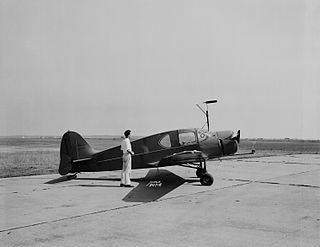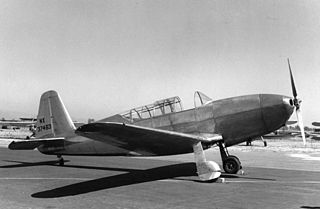Related Research Articles

The Piper PA-32 Cherokee Six is a series of single-engine, fixed landing gear, light aircraft manufactured in the United States by Piper Aircraft between 1965 and 2007.

The Piper PA-24 Comanche is an American four-seat or six-seat, low-wing, all-metal, light aircraft of semi-monocoque construction with tricycle retractable landing gear. Piper Aircraft designed and developed the Comanche, which first flew on May 24, 1956. Together with the PA-30 and PA-39 Twin Comanche, it made up the core of the Piper Aircraft lineup until 1972, when the production lines for both aircraft were wiped out in a flood.

The Aero Commander 500 family is a series of light-twin piston-engined and turboprop aircraft originally built by the Aero Design and Engineering Company in the late 1940s, renamed the Aero Commander company in 1950, and a division of Rockwell International from 1965. The initial production version was the 200-mph, seven-seat Aero Commander 520. An improved version, the 500S, manufactured after 1967, is known as the Shrike Commander. Larger variants are known by numerous model names and designations, ranging up to the 330-mph, 11-seat Model 695B/Jetprop 1000B turboprop.

The Pitts Special is a series of light aerobatic biplanes designed by Curtis Pitts. It has accumulated many competition wins since its first flight in 1944. The Pitts biplanes dominated world aerobatic competition in the 1960s and 1970s and, even today, remain potent competition aircraft in the lower categories.

The PA-25 Pawnee was an agricultural aircraft produced by Piper Aircraft between 1959 and 1981. It remains a widely used aircraft in agricultural spraying and is also used as a tow plane, or tug, for launching gliders or for towing banners. In 1988 the design rights and support responsibility were sold to Latino Americana de Aviación of Argentina.

The Stinson 108 was a popular general aviation aircraft produced by the Stinson division of the American airplane company Consolidated Vultee, from immediately after World War II to 1950. It was developed from the prewar Model 10A Voyager. Stinson was bought by Piper Aircraft in 1949. All Stinson model 108, 108-1, 108-2, 108-3 and 108-4 aircraft were built by Stinson at Wayne, Michigan. When Stinson sold the type certificate to Piper in 1949, approximately 325 airplanes of the 5,260 model 108s built by Stinson were complete but unsold. These 325 model 108s went to Piper as part of the sale. Piper then sold that inventory as the Piper-Stinson over the next few years.

The Bellanca 14-7 Cruisair and its successors were a family of single-engined light aircraft manufactured in the United States from the mid-1930s onwards.

The Cessna 310 is an American four-to-six-seat, low-wing, twin-engine monoplane produced by Cessna between 1954 and 1980. It was the first twin-engine aircraft that Cessna put into production after World War II.

The Fletcher FU-24 is an agricultural aircraft made in New Zealand. One of the first aircraft designed for aerial topdressing, the Fletcher has also been used for other aerial applications as a utility aircraft, and for sky diving.

The RyanNavion is and single-engine, unpressurized, retractable gear, four-seat aircraft originally designed and built by North American Aviation in the 1940s. It was later built by Ryan Aeronautical Company and the Tubular Steel Corporation (TUSCO). The Navion was envisioned as an aircraft that would perfectly match the expected postwar boom in civilian aviation, since it was designed along the general lines of, and by the same company which produced the North American P-51 Mustang.

The Cessna 340 is a twin piston engine pressurized business aircraft that was manufactured by Cessna.

The SOCATA Rallye is a light aircraft that was manufactured by French aviation company SOCATA. It was originally developed during the 1950s by French aircraft manufacturer Morane-Saulnier as the MS.880.

The Atlas H-10 was the prototype for a four-seat cabin monoplane aircraft, registered N37463, designed by Max Harlow, which was flown in the United States shortly after World War II.
The Parsons-Jocelyn PJ-260 was an aerobatic biplane aircraft built in the United States to participate in the 1962 World Aerobatic Championships in Budapest. It served as the prototype for a family of closely related aircraft produced under designer Nick D'Apuzzo's name as the D-260 and D-295 Senior Aero Sport', D-200 Junior Aero Sport and the D-201 Sportwing which were marketed for homebuilding. The original PJ-260 was named for the pilots who commissioned the aircraft and hoped to compete with it, Lindsey Parsons and Rod Jocelyn. The PJ-260 and its derivatives were conventional short-coupled biplanes with fixed tailwheel undercarriage. The single-bay, equal-span wings were staggered and braced with N-struts, and the outer panels of the upper wing were swept back. The fuselage construction was of fabric over a steel-tube framework, and the wings were of fabric-covered wooden spars and metal ribs.

The Isaacs Fury is a British homebuilt sporting biplane designed by John Isaacs as a seven-tenths scale replica of the Hawker Fury fighter.

The Wassmer WA-51 Pacific is a French four-seat cabin monoplane designed and built by Société Wassmer. Different-powered variants include the Wassmer WA-52 Europa and the Wassmer WA-54 Atlantic. It was the world's first composite material-built aircraft.

The Johnson Rocket 185 was a 1940s American two seat cabin monoplane designed by Johnson and built at Fort Worth, Texas.

The Robin DR.200 is a family of French conventional landing gear single-engined light touring or training cabin monoplanes. Originally produced by Centre Est Aéronautique the company later changed its name to Avions Pierre Robin.
The Omega BS-12 was a utility helicopter with high ground clearance designed to carry loads behind the cabin at, or near, the center of gravity.

The Team Rocket F1 Rocket is a two-seat sport plane formerly built in Czech Republic and marketed as a kit for amateur construction by Team Rocket of Texas, United States. As of April 2017, the aircraft is being produced in the U.S. under license from Team Rocket by Frazier Aviation of Indiana.
References
- ↑ letter from Regent Aircraft to "Aeronautical Engineering Review" dated May 5, 1954
- ↑ "Western Flying" June 1951
- ↑ Jane's All the World's Aircraft 1954–1955[ page needed ]
- ↑ "Western Flying" June 1951[ page needed ][ title missing ]
- ↑ FAA registry records for N77637
- ↑ "Air Progress Aviation Review" August 1980 page 7
- ↑ Johnson 260 sales brochure
- ↑ "Western Flying" June 1951